What is the greatest moment or scene in all of Star Wars…?
In commemoration of this year’s world Star Wars Day, I’ve decided to pick out the 20 Greatest Star Wars Moments (in my opinion, of course). Star Wars is and has been so much a part of my life that it was hard to narrow this post down to just twenty.
There’s no other film franchise I can think of where it would be so difficult to narrow the list down to twenty; I’m actually not sure there’s another franchise where I could build the list up to twenty in the first place.
No film franchise, and possibly no entity in popular culture, has made itself so embedded a part of our collective cultural landscape and collective consciousness than the Star Wars films have. From first seeing Empire Strikes Back as seven-year-old to purchasing my first Return of the Jedi action figure (for the record, the Princess Leia ‘Boush’ figure was my first Star Wars toy – 1985; purchased for seventeen pence), to reading Splinter of the Mind’s Eye, through to seeing the trailer for The Phantom Menace and going mad with anticipation, and having the hairs on my skin stand on edge when I watched Revenge of the Sith; the House That Lucas Built has been a vital part of my life for literally as long as I can remember.
This is a list selected by someone who’s been in love with Star Wars for two and a half decades. It’s also the kind of list that is better selected after a suitable amount of time has passed and the films have had some time to age.
It is now nine years since the last proper Star Wars film and enough time has passed since the point where anti-prequel hatred was viral (though there’s still lots of anti-prequel hatred); so I imagine I can put forward an honest list of this type without attracting too many scathing remarks from those crowding the prequel-hate bandwagon.
And regardless what becomes of the Star Wars legacy in the near or distant future, regardless of what happens next year, nothing can take away from the memory and the lasting effect of the franchise’s past glories and special moments.
Not all Star Wars fans are going to agree with this list, of course; and there’s things I’ve left off this list that I really wanted to include – including the speeder bike chase from ROTJ or the Battle of Hoth. But I can’t include everything. Maybe one day I’ll have the time to do a top forty or top fifty?
But lists of this type are much more interesting when they’re subjective and honest anyway, and not pandering to common opinion in some attempt to somehow be ’empirical’.
With all that said, let’s begin…
20. Obi Wan Versus Jango Fett (Attack of the Clones)
Right off the bat, I’m going with a somewhat maverick choice here.
But, dammit, this is just a fun, incredibly cool and mostly lightsaberless showdown in the rain between Obi-Wan (played Ewan by I’m-having-the-time-of-my-life McGregor) and Daddy Fett, while little Boba watches on and picks up tips. Having said that, Jango might’ve wished he’d lost here to Obi-Wan instead of the indignity of having his head lopped off by Windu later on.
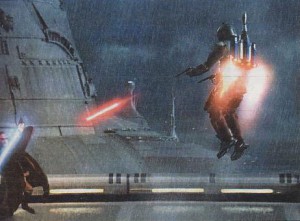
Obi-Wan was the best thing about Episode II and this simple one-on-one fight sequence was much better than most of the much bigger-scaled action later on in the Geonosis arena sequences. The fact that Kenobi essentially loses his Jedi weapon and the thing descends into an old-fashioned fist-fight is part of the charm. And this was also Lucas’s attempt to give fans what they hadn’t gotten in the Original Trilogy – specifically, a full-on fight featuring Boba Fett (albeit, it’s Daddy Fett this time).
19. Luke Arrives at Jabba’s Palace (Return of the Jedi)
Nothing spectacular happens here.
But once you’ve seen films like Return of the Jedi for the thirtieth time it’s no longer the big moments or action sequences that you notice, but the smaller, more subtle elements. In this instance, it’s that giant door squealing open and Luke’s silhouette appearing.
It’s the moment you know shit’s going to kick off; the hero has arrived to rescue his friends.
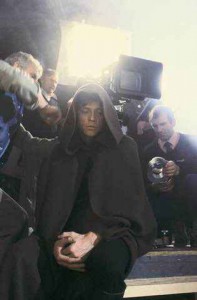
But it’s more than that – it’s the difference in Luke Skywalker; when last we’d seen him it was as the young man who was caught utterly off-balance on Cloud City, who couldn’t handle his father, who wasn’t ready to face that situation (just as Yoda and Obi-Wan had tried to warn him), and who ended up hanging on for dear life and needing to be rescued by his friends despite having gone there to rescue them.
But now he’s different – now he strides into the enemy stronghold with calmness and serenity, puts two Gamorrean guards out cold with barely any effort (using a Dark Side Vader-like move, in fact, which foreshadows his later temptation to the Dark Side by Palpatine), and waltzes into Jabba’s chamber to calmly demand what he’s come for.
We see immediately that he is a changed man; he’s a Jedi now and with a Jedi demeanour to match.
The fully-realised Luke Skywalker has arrived; it truly is the ‘Return of the Jedi’.
Would’ve been even better had the deleted scene of Luke constructing his new lightsaber been included at the beginning; but even so it works pretty damn well anyway.
18. Chewbacca Trying to Re-Assemble 3P0 (Empire Strikes Back)
I’m sure it’s not a moment that immediately comes to mind for most people, but there’s always been something poignant to me about this very short moment with Chewie trying to reassemble the smashed protocol droid.
Some of the most endearing moments in Star Wars don’t involve the ‘human’ characters at all; it was always extraordinary in the Original Trilogy how much emotion could be evoked from non-talking characters like Chewbacca or Artoo Deetoo. In this particular scene the Wookie’s distress at the situation – not Threepio’s pitiful state, but what’s going on with Han and what’s going to happen to Luke – comes across really strongly and I feel for him just as much watching it now as I did when I was seven years old.
I think there was always something about the Wookie’s inability to articulate his emotions that made his emotions translate even more powerfully; just this primal, guttural expression of sadness that expresses more than any dialogue could.
And, of course, Threepio’s characteristically prissy complaining offsets the sadness with humour at the same time, which is why the character dynamics of the Original Trilogy worked so well.
You cannot overestimate how important little character moments like this are to the overall film.
17. Death of Padme & The Birth of the Twins (Revenge of the Sith)
Inter-cut with the Frankenstein images of Anakin Skywalker being transformed against his will into Darth Vader, a distraught Padme gives birth to Luke and Leia as the prequel trilogy reaches the dramatic point it had been building to for three movies and a stressed-out Obi-Wan and Yoda look on, wondering what this means for the galaxy and the Force.
There are really three things happening in this sequence; Padme is giving birth to the heroes of the OT, Darth Vader is being born/created, and Padme’s life-force is slipping away. The way those three things are juxtaposed and inter-cut is an extraordinary feat of editing; underscored by the stirring music.
This is the most immaculate encapsulation of George Lucas’s epic filmmaking: it is operatic in its nature, a potent synthesis of wordless imagery, stirring choral music, and archetypal themes of birth, death and rebirth – all happening at once. The way Anakin Skywalker’s ‘death’ runs parallel to Padme’s death – and Vader’s ‘birth’ runs parallel to the birth of the twins – is visually and conceptually stunning.
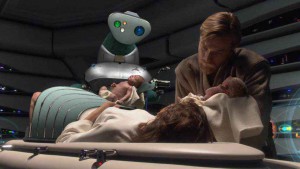
Padme herself is the symbol of all that was good in the Republic and the galaxy: her death is symbolic also of the death of democracy and liberty. But built in to her death is the ‘birth’ of the ‘new hope’; in the form of her children – thus even as she and the Republic is dying, the seeds of its restoration are literally coming into being, to be nursed and safeguarded by the last surviving Jedi Knights (Obi Wan Kenobi and Yoda).
It’s Padme’s final words that really give this moment its lasting poignancy; “I know there is still good in him,” the once proud and dutiful woman who has now given up on life tells Obi-Wan.
Having seen what Anakin has become and having (as far as he knows) destroyed the boy he’d tried to train, Obi-Wan will never put stock in Padme’s assertion that she has spoken out of enduring love for the Anakin that once was.
But it is Luke who will inherit this belief from a mother he’s never met – a belief and conviction in the goodness that is still within the father he has never known.
Once again it’s the key moments in Revenge of the Sith and Return of the Jedi that really complete the circle of the Star Wars saga. For all the gripes that are rightly or wrongly leveled at the prequel trilogy, Revenge of the Sith put so much right and really did join the two trilogies together, not just with plot details but with emotional resonance and unifying themes.
As for the haters, who joke about Padme dying ‘of a broken heart’: it’s simply a dumb misreading of the story. Nowhere in the dialogue is a ‘broken heart’ mentioned. The medical droid talks about her losing the will to live – but that is simply a droid trying to make sense of a mysterious situation in its limited, droid-like way.
The best interpretation of Padme’s death out there is that Palpatine was in fact using the Dark Side of the Force to draw the life-force out of Padme and use it to keep Anakin alive as he was being put into the life-support Vader suit. Which would in fact explain why Lucas made it a point to show her death and Vader’s first breaths happening simultaneously.
Either way, this whole sequence is an extraordinary climax to the prequel trilogy story.
16. Opening Sequence, Battle Over Coruscant, Killing of Count Dooku (Revenge of the Sith)
I know this is more than one scene technically, but it all flows so smoothly together that it’s difficult to separate it into its constituent elements. The best opening to a SW movie we’ve had and one of the best openings to a film I’ve ever seen, diving headlong into the high-octane space battle in all its rich detail and multitudinous elements.
From the very first shot of the two Jedi Fighters joining the immense battle over Coruscant, to the sight of Obi Wan and Anakin soaring into the Invisible Hand, lightsabers quickly drawn, to the goosebump-inducing duel with Count Dooku and his beheading by a Dark-Side-bound Anakin Skywalker; just brilliant.
The sheer amount going on in those first five minutes or so in every frame and in every part of every shot is staggering; you can be watching it for the tenth time and still noticing cool details you missed before. Culminating in the duel with Count Dooku, we see the film’s first indication of Anakin’s journey towards the Dark Side as Dooku tries to manipulate and provoke the young Skywalker without realising that it’s going to result in his own death.

The shot of Anakin beheading Christopher Lee’s character with two lightsabers is one of the most memorable visuals in the entire saga – and one of the darkest.
What also really works well is the connection yet again between Revenge of the Sith and Return of the Jedi – the parallel between Palpatine sitting and watching Anakin and Dooku fighting to the death and Palpatine sitting and watching years later as Anakin and Luke have the same fight; in both cases Palpatine is watching his old apprentice fighting his soon-to-be apprentice.
This scene honestly gave me goosebumps when I first saw it in the cinema; it’s all the more fascinating because you already knew what Anakin’s fate was. But also what’s brilliant about this whole ROTS opening sequence is that you’ve got everything in it; the action, the space battle, the humour and banter, the manipulation and scheming, the darkness, even the Artoo-Deetoo moments, all within the first 10-15 minutes.
And again the level of detail: even in the interior scene when the focus is on Anakin, Obi-Wan and Dooku, we’re still seeing so much detail in the exterior battle sequences visible from the windows. That level of detail isn’t just visual: the sound design and details in this sequence are unbelievable.
And whoever had the idea of doing the battle in the upper atmosphere of the planet instead of out in space was a genius.
15. Boonta Eve Podrace (The Phantom Menace)
I don’t comprehend how anyone can dismiss The Phantom Menace when it has this sequence in it. On a technical level, the Boonta Eve Podrace might even be the greatest overall action sequence in Star Wars.
It’s immaculately conceived and realised, it’s tongue-in-cheek, it’s visually incredible, it’s rich in detail and layer, even the sound design is utterly superb. The amount of meticulous work that went into creating this sequence – which on its own took two years to complete – is mind-blowing. The artists and designers who brought this thing to life, from the conceptual stages to the end product, did an extraordinary job. Setting out those amazing backdrops and gargantuan canyons, ravines and landscapes in the desert was an immaculately executed job in itself, even without the actual race.

The race itself is fabulous, partly inspired by the chariot race in Ben Hur (right down to Sebulba trying to do the dirty tricks like Messalla) and part Wacky Races, but underline by Lucas’s love of motor racing and fast cars. It’s just an immense sequence that is pulled off perfectly and that no other filmmakers would’ve even dreamt of attempting. The scale of it, the ambition and vision, is to be marvelled at, from the vast backdrops, the Roman style arena and the panache and bombast of the race, right down to the great designs of the pods themselves and all the little add-ons like the intriguing shot of Aurra Sing, the wandering Jawas, the Tuskens sniping at the racers, and the fact that we see a younger Bib Fortuna with a younger Jabba the Hutt who watches the whole thing like a bemused, bored Pharaoh (and even falls asleep).
I challenge anyone to find me any sequence in any film ever made and put it up against this podrace sequence for technical, visual or editing brilliance. The fact that a technical or special-effects Oscar wasn’t forthcoming for this sequence alone is demonstrative of the extent to which Hollywood resented and disliked George Lucas.
14. The Millennium Falcon Asteroid Chase (Empire Strikes Back)
As much as I also liked the asteroid sequence in Episode II, whenever I see the original Millenium Falcon asteroid scene I immediately am transported back to my six-year-old self seeing it for the first time on TV and being blown away by it.
It’s only flaw is that it should go on a little longer. The whole post-Hoth Falcon-fleeing-Star Destroyers sequence is awesome anyway, but it’s the asteroid belt that kicks arse the most, as Han Solo ducks, dodges and swerves to avoid the giant floating rocks, while the pursuing Tie-Fighters one by one meet their explosive ends.
Han Solo at his coolest. And what the great maestro John Willaims does with the music – it goes without saying by now – is utterly awesome.
13. Yoda Takes Out the Imperial Guards (Revenge of the Sith)
As far as I’m concerned Yoda’s two most kick-arse moments both occur in Revenge of the Sith; the first is when he beheads the two Clone Troopers on Kashyyyk and the second is this brief moment when he casually deals with the Emperor’s two guards, knocking them out like a bunch of pussies.
Priceless. Forget the duel with Dooku in Episode II, Yoda’s at his coolest with little moments of understated superiority like this.
The actual drawn-out showdown with Palpatine that ensues after this is actually one of the few things I didn’t like about Episode III; I dislike that sequence for the exact reasons why I do like this tiny preceding moment so much – whereas the bigger fight sequence has too much dialogue (some of it very bad) and is too overblown and drawn-out, this wordless, brief moment of Yoda taking out the two guards exhibits the tiny Jedi Master’s power and effortless coolness much more effectively.
What’s funny is that some of us fans were waiting for years to see those red Imperial Guards have an action sequence (which we didn’t get in Return of the Jedi): and Lucas teases it for a micro-second here, only to have the diminutive Jedi Master knock them unconscious with the tiniest gesture of his fingers. Was George trolling us? Or did he just love Yoda so much that he wanted him to have this moment of bad-assery?
As an aside, I actually think the Yoda/Palpatine fight would’ve been much better with Yoda having no dialogue at all; it would’ve been much more powerful if Yoda just let Sidious do all the talking and just focused himself on silently, wordlessly and angrily trying to carry out his mission and destroy the Sith Lord.
Unfortunately, Uncle George did not consult me on the final draft of the screenplay.
12. Duel of the Fates (The Phantom Menace)
I’m personally very bored of the Phantom Menace hate; I was bored of it years ago actually and I’m stunned that it’s still going on so much fifteen years later.
The climatic confrontation between Darth Maul and the Jedi is of course the centrepiece of the entire movie and is, I maintain, one of the greatest moments in all Star Wars. It is superb on multiple levels, some obvious and some more subtle. The choreography is magnificent, the sequence is visually stunning, and the whole thing is bathed in the glory of John Williams’ epic ‘Duel of the Fates’ score.
From the moment the (phantom) menacing Darth Maul makes that brilliant entrance, revealed as the doors slide open, the entire sequence flows beautifully, like a stunning synthesis of opera and performance art.
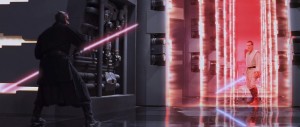
That sequence with the forcefields is a brilliant touch, as it plays with momentum and increases tension – before this, we’d been watching a fast-flowing, highly kinetic fight sequence, but then it suddenly just comes to an abrupt halt.
This whole sequence is filled with terrific, albeit subtle, little details. What we see here is a young, reckless Obi-Wan who comes at Maul with too much aggression and emotion, while Maul, by comparison, is all calm, eloquent and at one with the Dark Side of the Force. In Episode III, an older, wiser Obi-Wan is now the one fully in-tuned with the Force and it is Anakin who is emotional, undisciplined and pretty much self-defeated, the way Obi-Wan is in Episode I.
There are two things in particular I think are superb creative decisions on Lucas’s part in this sequence. The first, as I noted above, was having Obi-Wan and Qui-Gon be separated by the forcefields. It just added so much more tension to the sequence. We may take it for granted now, but think about it: it wasn’t necessarily an obvious choice. Lucas could’ve just as easily had Qui-Gon killed during a continuation of the three-way duel. But by separating Qui-Gon and Obi-Wan, the sequence becomes so much more dramatic. Every time I watch it, I can *feel* Obi-Wan’s tension and helplessness as he watches, unable to join in; I mean I literally feel twitchy and restless, almost wanting to get up and join in myself.
The second genius thing is when Qui-Gon is eliminated and we get down to that brief Obi-Wan/Maul solo duel – which is so good, by the way. Aside from the stunning speed and fluid choreography, it is also aided by the complete silence; this was a genius dynamic, because the whole sequence until then was awash in the compelling choral tones of the ‘Duel of the Fates’.
But after Qui-Gon is out of it and we come back to an angry, over-eager Obi-Wan waiting to get revenge, there is no music: instead Kenobi and Maul fight in silence, the hums and clashes of the lightsabers themselves becoming a sort of naturalistic music.
For anyone who mocks The Phantom Menace or dismisses it out of hand, I invite you to re-watch this entire sequence.
11. Yoda’s First Appearance (Empire Strikes Back)
“Away put your weapon – I mean you no harm!”
Without doubt the best introduction moment that any Star Wars character had; this playful, slightly senile Yoda that appears to Luke on Dagobah was perhaps somewhat missed in the Prequel Trilogy where Yoda was much more solemn and less endearing.
But then maybe a decade or two living alone on a swamp planet loosens you up a bit; or maybe it’s the change of pace that comes with retirement. Does Yoda recognise Artoo Deetoo here? Does everyone’s favourite astromech droid recognise the aged Jedi Master, for that matter? Who knows?
But what an entrance for a character; though of course all the Yoda/Luke scenes in ESB are absolutely priceless. The cleverness of the story here is the subverting of expectations: we, as an audience, and Luke as a character, are expecting this great Jedi Master to look like something big and powerful: instead we get this tiny green troll who speaks funny and comes across like a practical joker.
But, of course, the aged Jedi Master is merely playing with his visitor: putting on an act and feeling Luke out. It’s a great lesson about the deceptiveness of appearances and not judging a book by its cover: and also that Luke was thinking about the Force and the Jedi all wrong.
10. Order 66: The Jedi Extermination (Revenge of the Sith)
The Sith’s ‘Night of the Long Knives’. It’s tough enough watching the moment when the hiding children in the temple approach the now Dark-Side Anakin innocently expecting that he’s there to protect them; but the sublime montage sequence of various Jedi being killed off in various locations just prods at the gut, especially watching the elegant Ki-Adi Mundi being gunned down by his own troops.
All the different CGI locations are so beautifully rendered, especially considering that they only get about twenty seconds of screen time each, and the absolutely beautiful John Williams score for this sequence evokes the sense of injustice and tragedy perfectly.
The historic allusion to the SS (here represented by the Stormtroopers/Clonetroopers, with Palpatine I guess as Hitler) certainly adds an additional layer of resonance to it, but really it’s the sense of all the heroism, nobility and wisdom being coldly and systematically eliminated from the galaxy by these literal clones who have no independent thought or conscience and no loyalty to their commanders.
Yet, being Star Wars, even this bleak sequence has its triumphal moment when the Clonetroopers come to assassinate Master Yoda and add him to the list of dead Jedi – but Yoda senses their intent, leaps up and decapitates both of them in one swift, kick-ass motion. I’ve never been so glad to see someone get their head cut off; and I’ve never wanted to cheer so much as when Yoda does the business here.
It’s a small comfort, given everything else that’s just happened; but it’s about as celebratory as ROTS allows.
9. The Emperor Tries to Seduce Luke… (Return of the Jedi)
I know this technically is broken up into several scenes, but I’m counting it as one.
The whole Palpatine attempt to get under Luke’s skin, to manipulate his feelings and turn him to the Dark Side, is possibly one of the most skin-crawling depictions of evil there has ever been. Ian McDiarmid is just masterful in this whole sequence and it stands as possibly the greatest depiction of fantasy or comic-type villainy of all time; the only performance I can think of that might equal McDiarmid’s Palpatine is Heath Ledger’s The Joker.
Every sentiment is so cruelly, so gleefully delivered, every word so pronounced and so cutting, it’s even more fun to watch as an adult than it was creepy to behold as a kid. He is just so convincing as the embodiment of all evil in the galaxy; and the darkness in these scenes – the Emperor’s maliciousness, Luke’s darker nature and demeanour, Vader’s quiet, almost sidelined role in things now, and John Williams’ creepy, stirring ‘Sith theme’ – just builds up slowly and deliberately towards our dark, tortured climax.
As I’ve said elsewhere too, the inter-dynamics of the Star Wars films are most powerful between Revenge of the Sith and Return of the Jedi; and nothing more so than the parallels between Palpatine’s seduction of Anakin in ROTS and his attempted seduction of Luke in these scenes. But he seems much more into it in ROTJ; by now his sickness and maliciousness is a couple of decades stronger, and whereas he seduced Anakin through careful, long-term manipulation, his attempted seduction of Luke is much more about sheer force of will.
And he is so focused on the temptation of Luke and the destruction of the Rebel Alliance that he doesn’t see Anakin’s reemergence coming.
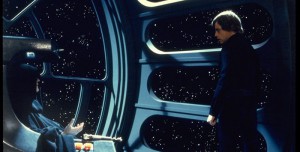
He never even considers Darth Vader a threat; that’s how diminished Anakin Skywalker has become by then in the Emperor’s eyes.
I was always so creeped out by the Emperor in these scenes when I was a child. And watching Revenge of the Sith as an adult brought it all back to me while adding a more complex element of manipulation; watching and comparing the Palpatine/Anakin scenes in ROTS and the Emperor’s scenes in ROTJ is fascinating.
George Lucas has often described the story elements in the saga as a repeating motif; the same patterns repeating themselves with the sort of rhythm of poetry. More than anywhere else it’s evident in Palpatine’s way of operating. But the best thing about the Emperor in ROTJ is simply how gleefully Ian McDiarmid bites into the role; as Lucas said of him, “He’s just so evil!”
8. The Holy Trinity Reunited (Return of the Jedi)
Yes, the simple appearance of the ghosts of Obi Wan, Yoda and Anakin at the end of ROTJ; they appear to Luke to let him know that Anakin has been redeemed and that the Force has been put somewhat back into balance. A very necessary moment that gives the Star Wars saga it’s final spiritual, life-affirming quality, the same way the Risen Jesus does in the Gospels.
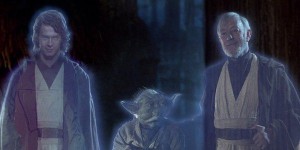
Furthermore, I’m going to stick my neck out here – and I know LOTS of Star Wars fans will disagree with this next statement – but I PREFER the Hayden Christensen version as seen in the revised-revised ROTJ edition. I’m sorry – troll me if you like, but I’ve said it. To me it firmly and finally connects the two trilogies beautifully.
Speaking as someone who properly, genuinely liked Revenge of the Sith a lot, that direct visual connection works very nicely for me, even if the logic doesn’t necessarily hold together. My childhood self (ROTJ) and my adult self (ROTS) were both happy. “Purists” (though how you can be a “purist” and hate George Lucas, I’m not sure I understand) can gripe all they want: but when Hayden appears as Anakin’s ghost, it is as emotionally as potent a moment as anything in the saga.
For that matter, the entire end celebration in the Ewok village should be included here as one of the greatest moments in Star Wars. It was always a poignant ending anyway, but once you’ve now been through the fuller six-film story, reaching this end-point is so much more satisfying, so much more emotional and offers so much more closure.
8. Luke vs Vader on Bespin (Empire Strikes Back)
From the moment Luke rises up into that chamber and sees the imposing figure of Vader standing at the top of those lit-up steps (preceded by the audio of Vader’s ominous breathing), what unfolds is sheer cinematic perfection.
The entire thing is visually stunning: the atmosphere thick with industrial fog, eerie blue backdrops and orange electric lights. The two sabers clashing tunefully amidst this backdrop of visual art, this is the moment the entire film has been building up to. Vader is merely toying with his son: we know and sense that he could dispose of Luke easily.
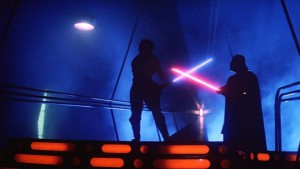
As the duel progresses, the tension builds and along with it the inescapable sense that Luke is headed towards disaster. And he is. Not ready for this fight, nor for the revelation it will bring, it climaxes finally with the most famous dialogue in cinema history.
The “I am your father” reveal is so prevalent by now in popular culture that it has no shock value anymore. But it is still powerful: all the more so for Luke’s agonised reaction and Mark Hamill’s depiction of total despair and denial. Vader’s words are more painful to Luke than his arm being severed.
And that deliberate letting-go: that drop into the abyss to escape Vader gets more and more powerful every time I watch it. Is it a leap of faith? Or a drop of despair?
Is Luke giving up his life? Or giving in to the Force itself? I’m never entirely sure – but wondering about it always makes this climax all the more fascinating.
7. The Anakin/Padme Force-Connection Scene (Revenge of the Sith)
A scene that seems to get overlooked by most. But the significance of this scene cannot be overstated. It is the moment where the fate of the galaxy is essentially decided: where Anakin Skywalker’s path is set and where the last breath of hope for the Republic and for the Jedi is extinguished like a candle-flame being put out.
And, just like a candle’s flame being put out, it happens quietly and without fanfare or action. Only two people – Anakin and Padme – are experiencing this moment: while battles and conspiracies and vast plots are unfolding elsewhere, Lucas boils it all down to an intimate moment between two people. Two people who ultimately can no longer help each other – or the galaxy.
This is, in fact, the last real contact or connection between Padme and Anakin: the Anakin that exists beyond this scene is more Darth Vader than Anakin Skywalker.
While we can make fun of the Anakin/Padme romance scenes in all three prequels til we’re blue in the face, there were some moments that transcended that: most of all this simple, wordless scene in ROTS where Anakin has just told Windu that the Chancellor is the Sith Lord and Windu has told him to go wait in the Jedi Council chamber while they go to arrest Palpatine.
As Anakin desperately tries to grapple with the urgent situation, trying to decide what to do, he looks across Coruscant towards where he senses his wife is and we cut to Padme in her apartment looking back across the sunset-laden cityscape to the Jedi Temple where she can sense Anakin reaching out to her through the Force.
I’ve always found it poignant, even powerful – the music, the incredibly vivid visual look and feel of the scene, and the tension as we try to work out what Anakin is going to do. Nothing is communicated between them; if anything had been communicated, you wonder what exactly it would’ve been at that point.
The fact that this is a silent moment might ironically be a reason why it works so much better than most of the Padme/Anakin scenes in other films – there’s no bad dialogue to get in the way, it’s all just feeling and sensation and tone and tension, it’s completely impressionistic.
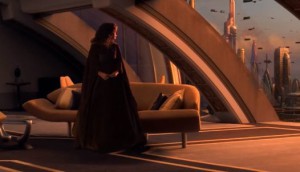
George Lucas has often said that the best of Star Wars is often like “a silent movie”; and in a scene like this you can see what he means. This is basically silent cinema.
We’re never told what exactly Padme is feeling or thinking, but also what’s fascinating about this scene is the implication that Padme may have some low-level Force sensitivities herself. The other dimension of why I find this scene poignant is that it connects very strongly, for me anyway, with the brief Luke/Leia Force connection moment in Empire Strikes Back when Luke is hanging off Bespin, calling out to be rescued.
The difference of course is that whereas Leia rescued Luke, Padme is powerless to do anything for Anakin here.
This is Star Wars at its most primal and powerful; and its most visually stunning. This sequence is a masterclass of editing and framing. And the music – one of the stranger, more off-beat pieces of music John Williams has done for Star Wars – also imparts so much to the emotion and tension.
Sublime.
6. Luke’s Descent/Force Connection (Empire Strikes Back)
And so, fittingly enough, at No.5 I’m putting the aforementioned scene that connects directly with the Anakin/Padme scene cited above.
The whole escape from Cloud City sequence could be here in its entirety, it’s so superb; but more specifically I’m referring to Luke’s despairing, hopeless leap from the gantry and his long fall.
As he hangs off the rails of the Cloud City, a bottomless descent beneath him, traumatised and out of all hope, he does the only thing left to him – he reaches out with his feelings and calls to Leia. Leia, far away on the Falcon can feel his call; a close up on her face as she senses her deep connection to him, accompanied by a gentle swell of the Force Theme.
It’s a simple, poignant moment, made all the more so because Leia doesn’t even know at this point that she and Luke are twins.
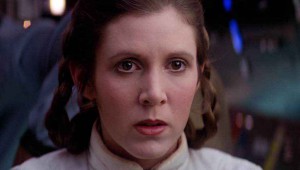
It’s one of those moments, in fact, that’s much more meaningful post-prequel trilogy, now that we have much more of a sense of where Luke and Leia came from and what their parents went through; I consider this something of a sister scene to the Anakin/Padme ROTS moment mentioned above. While this entire final act of Empire is generally a cinematic masterclass – Han’s freezing in carbonite, Luke’s defeat at Vader’s hands, Artoo Deetoo’s heroics, Chewbacca having to re-assemble C3PO, Boba Fett’s mysteriousness, Leia and co’s rush to stop Slave 1 from departing with Han – it’s this quiet spiritual moment between brother and sister that I most think of when I think of Empire, as the humbled, devastated Luke has to be rescued by the very friends he’d come to try to rescue himself.
The visuals, the stirring musical undercurrent, the masterful editing: it’s all here and it all elevates this moment beautifully. This is cinema as art.
Also, the emotion and meaning that Carrie Fisher is able to express in those close-ups on her face… I mean, it’s just on another level.
5. Battle Over Endor and Final Death Star Run (Return of the Jedi)
For all the incredible effects sequences and CGI across the six films, you still just can’t beat this final action sequence in the Original Trilogy, as Lando and the Millennium Falcon enter the superstructure and fire on the power generator and frantically flee the fiery cascade in a race against time through the Death Star’s labyrinth of tunnels.
I can’t count how many times I’ve seen this sequence plagiarized in various ways in other films and TV shows since.

Further, the entire space-battle sequence that ends ROTJ remains the best such sequence in the saga, even including the opening sequences of ROTS. Just all of it – from the tension in Lando throughout to all the little shots of the Falcon dodging and weaving amid Tie-Fighters and Star Destroyers, it’s just a feast for the eyes. This is the final battle to bring down the Galactic Empire – and you can feel the weight of it throughout, the all-or-nothing, now-or-never stakes and emotions.
All of it is masterfully edited. The special effects (this was 1983, for crying out loud) are out-of-this-world. The scope is unbelievable. And the way it’s all offset against what’s going on with Luke, Vader and Palpatine on the Death Star just adds even more to the tension.
What a way to finish up the trilogy.
And it may court controversy to say it, but I submit that Lando Calrissian may be an even bigger bad-ass than Han Solo.
4. Windu Versus Palpatine (Revenge of the Sith)
Honestly, I almost had this at No.1 on this list. But, after several reevaluations and reshuffles, I moved it back to here.
But this sequence – beginning with the four Jedi Masters arriving to arrest the Emperor and ending with Windu’s death and Anakin’s being christened as Darth Vader – is the most intense and nailbiting several minutes in the entire franchise. And Lucas put so many nuances and surprises into this sequence to make it less than obvious: Windu actually defeating Palpatine, Palpatine playing the helpless old man to trick Anakin, etc.
Perhaps a tad overlooked, drowned out by the bigger sequences, this deadly fight for control of the Republic and the galaxy is suitably understated, effectively offsetting the more dramatic fights and sequences in the film.
This confrontation, more than any other in the film, determines the fate of the galaxy.
While the later Yoda/Sidious duel in the Senate Chamber is the scene more directly designed to represent the death of the Republic and birth of Empire, for me it was always Windu’s scene that was the more dramatic and had the most tension. When Windu comes to arrest Palpatine there’s still everything to fight for; whereas by the time Yoda faces him later, all the damage has already been done.
Unlike the somewhat silly dialogue in the Yoda/Palpatine showdown, Mace Windu here wastes no words: it’s all business.
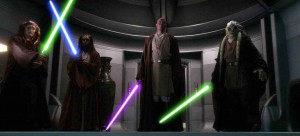
And the damn thing of it it is that Windu defeats Darth Sidious – it is simply Palpatine’s emotional manipulation of Anakin that seals the fate of the Jedi.
I object to the ease with which Palpatine takes out three of the supposedly greatest Jedi Masters (Saesee Tinn, Kit Fisto and Eeth Koth – who in this scene look like absolute pussies; Jar Jar would’ve put up a better fight), but aside from that it’s perfect; Sam Jackson’s swaggering in, Pulp Fiction style, the slow, cautious swordsmanship, the smashed window, Anakin’s tense arrival, Palpatine’s horrendous manipulation of the young Skywalker, and finally where it all goes horribly wrong and Windu is fried to death and tossed out the window like an unneeded banana peel.
That next moment when Anakin drops to knees before the Sith Lord is a more upsetting moment than virtually anything in the Original Trilogy, including Han Solo’s encasing in carbonite.
One of the most extraordinary things in this sequence is the genuine, palpable sense of Anakin being torn between two opposing influences and ideologies. It literally comes down to the Devil and Angel scenario, with Anakin standing there and trying to figure out who’s side to take: “He is the traitor!” Palpatine screeches, “Don’t listen to him, Anakin!” Windu urges him.
I almost can’t watch that moment – it’s so intense. But Lucas did such an amazing job of creating and depicting this tension and uncertainty that you really feel Anakin’s desperation: and can entirely understand how he ends up making the wrong choice. A wrong choice that has dire consequences for the entire galaxy.
What would’ve happened if Anakin had stayed out of it, as he’d been told to? Windu would’ve killed Palpatine. Would that have saved the Republic and the Jedi? Would the Empire never have been created? Or, in assassinating the Chancellor, would Windu have taken the Jedi down an untenable path? We can only perpetually wonder.
The music here, as contrasted to the Mustafar duel, is unintrusive, even unnoticeable, and the duel is slower, more suspenseful. When I first saw it in the cinema – and even now, watching it on DVD – this scene always gets me in the stomach; the sense of danger, the sense of impending doom, the sense of the stakes.
I cannot overstate how brilliant this whole sequence is.
3. The Twin Suns (A New Hope)
It’s the single shot that is most remembered from any Star Wars film and the shot that most resonates with people; as John Williams’ legendary Force theme swells, a bored, disenfranchised Luke Skywalker looks out across the breathtaking twin sunset on Tatooine, dreaming of adventures and longing to get away from the tedium of his desert life.
It speaks to the longing in every one of us, especially in our youth – the longing for excitement and adventure, the drive to get away from uninspiring surroundings and the suspicion that the grass is greener somewhere over that rainbow (or twin sunset).
In fact, like that Judy Garland moment in The Wizard of Oz, this simple shot remains one of the most iconic in cinema, and a perfect encapsulation of Luke Skywalker.
While not as powerful, the final shot of Revenge of the Sith with the infant Luke being held towards that same sunset provides a fitting bridge between the two films. In fact, the more I’ve thought about the twin suns on Tatooine, the more I’ve become convinced that the ‘twin suns’ represent the literal twins – Luke and Leia.
It took ROTS’s final shot to make this connection click into place for me: but I now think it was always there, all the way back in 1977. Though we didn’t get the revelation about Leia being Luke’s sister until 1983, the idea of it was encoded both into Empire (the Luke/Leia Force-connection scene, as highlighted in one of the above entries) and – I’m convinced – into A New Hope in the form of the twin suns. When Luke looks out at the two suns, he is – on some level – recognising that he is part of a dyad: two that are one, but that have been separated.
Which imparts even more resonance to this scene of Luke staring at the sunset: he’s not just longing for adventure, he’s longing for his actual twin – the part of himself he has been separated from without even knowing.
By the way, the fact that a real-life planet that’s been discovered in another galaxy has been nicknamed ‘Tatooine’ in regard to having two suns is a highly fitting tribute.
2. ‘Battle of the Heroes’: The Mustafar Duel (Revenge of the Sith)
A scene that every Star Wars fan had spent years and years wondering about.
Absolutely spellbinding from start to finish; even if bits of the dialogue can be left behind, visually the sequence is breathtaking, possibly the most dramatic, evocative and downright pretty action sequence you’ll ever see in big-budget cinema.
This sequence alone is an encapsulation of the power and potential of cinema itself: this is everything – opera, visual art, performance art and choreographed dance, and epic storytelling, all married to each other in an overwhelming synthesis of mediums.

But it isn’t just the speed and fluency of the fighting or even the dramatic lava-planet backdrop that truly mark this sequence out – it’s the underlying emotion of this fight-to-the-death between two people who once loved each other; you know from the first parry that this fight has a terrible outcome.
You can sense everything going on in Obi Wan’s mind – his remorse over having failed his student and the pre-knowledge that he will have to kill him – and everything going on in Anakin’s warped and damaged psyche too; the pain of losing Padme, the sense that everything he’s done in betraying the Jedi, murdering the children and turning dark, may have been for nothing; and the sense, at least until very late in the fight, that he doesn’t want to be fighting Obi Wan.
When Anakin is finally cut down after attempting the same maneuver Obi-Wan once used against Darth Maul, the full flood of emotion finally catches up with Kenobi and we can see this is a man who is questioning everything.
Through the entire duel, Anakin has fought with hate and anger and Obi-Wan has done the opposite – he has simply given himself over to the Force, doing what has to be done; this duality continues right to the bitter end, right through to their final parting sentiments, Obi-Wan answering Anakin’s bitter “I hate you” with “you were my brother, Anakin; I loved you.”
As Anakin’s body is engulfed and destroyed by the flames, one stage of the Star Wars saga is over in fire and brimstone, and when Obi-Wan picks up his student’s lightsaber and takes it with him to one day give to Luke we are immediately reminded that another stage of the saga is waiting to begin anew.
As in all great Star Wars moments, John Williams’ music is the heartbeat that amplifies and lyricises the emotional context of what’s going on; the ‘Battle of the Heroes’ (a more bittersweet adaptation of the ‘Duel of the Fates’ score from The Phantom Menace ) score here is just pitch- perfect, tonally encapsulating and capturing the underlying emotion of the confrontation.
The whole thing is absolute genius. Find me a fight scene or an action sequence greater than this. It was a rhetorical question – you can’t.
1. Luke’s Final Assault (Return of the Jedi)
It now looks very slow compared to the kick-ass lightsaber dueling of the prequel trilogy, but this final half-minute of the Luke/Vader contest at the end of Jedi is powered not by fancy moves or excellent choreography, but by the sense of emotion, climax and closure.
It is aided massively by that extraordinary and dark choral swell once Vader threatens Luke’s sister (you just can’t underestimate how much John Williams’s music adds to a scene or a moment like this) and Luke, devoid now of all hope, simply let’s rip into his father, no longer believing Anakin Skywalker can be redeemed.
Yet ironically it’s this very nothing-left-to-lose assault and Vader’s defeat that does induce the redemption of Anakin. In attacking in this way, Luke comes perilously close to the Dark Side himself – a moment much more resonant now that we’ve seen Revenge of the Sith. Post-ROTS, we now recognise that in Luke’s ultimate resistance to Palpatine, Vader sees the strength that he should’ve himself had all those years ago.
In other words, in Luke, Vader sees the better part of himself that was lost all those years ago. He also sees the son of Padme Amidala – not only the love of his life, but the very embodiment of the once free and democratic Republic that he helped destroy.
Thematically, there is a real resonance now between ROTS and ROTJ, particularly in Padme’s deathbed insistence that “there is still good in him”, her conviction that he can still be saved, and the naive, innocent (and ultimately correct) belief of her son here that this is true, even though the bitter and war-hardened Yoda and Obi-Wan disagree.

It’s Luke’s innocence and naivety that makes him the real hero of the Star Wars saga; he remains untainted by either ambition or tradition, nor jaded by the bitter history, but remains a naive idealist.
Played out in literal darkness and shadow, this is Star Wars at it’s most Gothic, and at it’s very best. This, for me, is the best, most powerful moment in all of Star Wars: it is a brother fighting not for himself but for his sister, a son displacing (and redeeming) his father, a lost soul being brought back to the light, an ultimate evil being undone, a galaxy being restored to freedom, and a saga reaching its climax.
______________________
And that’s my 20 Greatest Moments in Star Wars. If you disagree with it, have your say. And Happy Star Wars Day to all; May the 4th Be With you.
______________________





dude… No “speeder bike scene”? I guess that’s one of those things that is admittedly connected to my eighties childhood bias.. The lame podracer scene was just an attempt to revamp and upgrade the original excitement of the speederbikes zooming around the trees of Endor. Man… As a kid I remember that being like just the most amazing thing! I wanted a speeder bike so bad…
Of course, you know I’m prejudiced against the prequels. If I’m honest, I’d probably not put a single scene from any of them in my top twenty…
Dude, I love the speeder bike scene too – along with about 70 other scenes, but I limited it to a top 20! And these things are pretty subjective; I wasn’t really trying to be empirical. And hey, you can pooh-pooh the prequels all you like: I’m standing my ground. There was some brilliant stuff in the prequels. And do you *seriously* think the Ep1 podrace was lame…? I’m surprised, as you are otherwise a remarkably intelligent fellow…:)
Darth Vader’s epic line “The Emperor is not as forgiving as *I* am….”
Yep, and that whole scene. The tension is great, particularly when Vader ignites Luke’s lightsaber and examines it.
Fantastic! I thought about doing this today, but I am glad I didn’t. Yours is so much better! I might get to it eventually before the release of the new movie though. Two scenes that I love are when R2D2 is laser stunned by a Jawa in episode 4 and the whole scene where they carry him to their transport. The other scene is where we are introduced to the bounty hunters in episode 5. Again, well done. May the fourth be with you!!!!
Thanks, Robert 🙂 Yeah, those are two really nice moments. You’ve made me realise I haven’t included an ‘Artoo moment’ in this list; I should’ve really done a top 40 instead of 20! What’s great about that Jawa/Artoo scene is the sense of isolation and wilderness as Artoo is moving along nervously. And yes, the Bounty Hunter scene is pretty classic too.
Hey, you should definitely do your list too; I’d love to read it. And we can compare notes.
Reblogged this on theburningbloggerofbedlam.